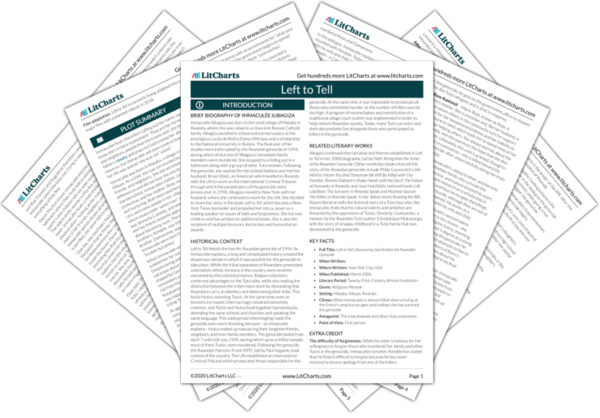Brief Biography of Immaculée Ilibagiza
Immaculée Ilibagiza was born in the small village of Mataba in Rwanda, where she was raised in a close-knit Roman Catholic family. Ilibagiza excelled in school and earned a place at the prestigious Lycée de Notre Dame d’Afrique and a scholarship to the National University in Butare. The final year of her studies were interrupted by the Rwandan genocide of 1994, during which all but one of Ilibagiza’s immediate family members were murdered. She escaped by a hiding out in a bathroom along with a group of other Tutsi women. Following the genocide, she worked for the United Nations and met her husband, Bryan Black, an American who travelled to Rwanda with the UN to work on the International Criminal Tribunal through which the perpetrators of the genocide were prosecuted. In 1998, Ilibagiza moved to New York with her husband, where she continued to work for the UN. She decided to share her story in the book Left to Tell, which became a New York Times bestseller and propelled her into a career as a leading speaker on issues of faith and forgiveness. She has two children and has written six additional books. She is also the recipient of multiple honorary doctorates and humanitarian awards.
Historical Context of Left to Tell
Left to Tell details the horrific Rwandan genocide of 1994. As Immaculée explains, a long and complicated history created the disastrous climate in which it was possible for the genocide to take place. While the tribal separation of Rwandans preexisted colonialism, ethnic tensions in the country were severely worsened by the colonial presence. Belgian colonizers conferred advantages to the Tutsi elite, while also making the distinction between the tribes more stark by demanding that Rwandans carry an identity card determining their tribe. This led to Hutus resenting Tutsis. At the same time, even as tensions increased, intermarriage remained extremely common, and Tutsis and Hutus lived together harmoniously, attending the same schools and churches and speaking the same language. This widespread intermingling made the genocide even more shocking, because—as Immaculée explains—Hutus ended up massacring their longtime friends, neighbors, and even family members. The genocide lasted from April 7 until mid-July 1994, during which up to a million people, most of them Tutsis, were murdered. Following the genocide, the Rwandan Patriotic Front (RPF), led by Paul Kagame, took control of the country. The UN established an International Criminal Tribunal which prosecuted those responsible for the genocide. At the same time, it was impossible to prosecute all those who committed murder, as the number of killers was far too high. A program of reconciliation and reinstitution of a traditional village court system was implemented in order to help restore Rwandan society. Today, many Tutsi survivors and their descendants live alongside those who participated as killers in the genocide.
Other Books Related to Left to Tell
Ilibagiza continued the narrative and themes established in Left to Tell in her 2008 biography, Led by Faith: Rising from the Ashes of the Rwandan Genocide. Other nonfiction books that tell the story of the Rwandan genocide include Philip Gourevitch’s We Wish to Inform You that Tomorrow We Will Be Killed with Our Families, Roméo Dallaire’s Shake Hands with the Devil: The Failure of Humanity in Rwanda, and Jean Hatzfeld’s twinned books Life Laid Bare: The Survivors in Rwanda Speak and Machete Season: The Killers in Rwanda Speak. In her debut novel, Running the Rift, Naomi Benaron tells the fictional story of a Tutsi boy who, like Immaculée, finds that his natural talents and ambition are thwarted by the oppression of Tutsis. Similarly, Cockroaches, a memoir by the Rwandan Tutsi author Scholastique Mukasonga, tells the story of a happy childhood in a Tutsi family that was devastated by the genocide.
Key Facts about Left to Tell
-
Full Title: Left to Tell: Discovering God Amidst the Rwandan Genocide
-
When Written:
-
Where Written: New York City, USA
-
When Published: March 2006
-
Literary Period: Twenty-First-Century African Nonfiction
-
Genre: Religious Memoir
-
Setting: Mataba, Kibuye, Rwanda
-
Climax: When Immaculée is almost killed when arriving at the French camp but escapes and realizes she has survived the genocide
-
Antagonist: The Interahamwe and other Hutu extremists
-
Point of View: First person
Extra Credit for Left to Tell
